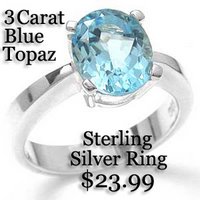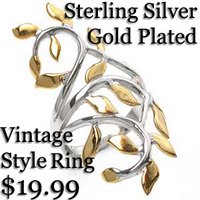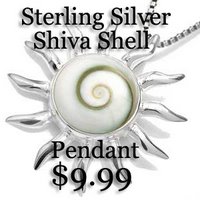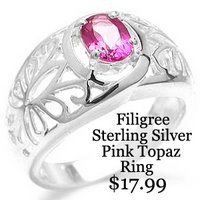Sterling Silver Summer Jewelry Fashions Of 2007

Well, aside from an on-hand 24-hour liposuction crew, more face-lifts than downtown New York and the sweetest of one-cal sugar daddies…not much! Happily, with the on-line world of information and affordable choice, those inconvenient inadequacies, stretched elastics and even tighter purse strings are as they say, excuse my French, ‘Passé.’ With the Internet’s choices, there really are no excuses not to update our wardrobes and still stay within budget! So what are the hottest fashion tendencies, colors, accessories and jewelry styles for the summer 2007?
 Some of the most appealing concepts and styles for this summer are ‘Futuristic’ –based around geometrics in metallic silver and gold, ‘Monochrome’ – Beat classic black and white styling, ‘Tribal’ – Ethnic global styles and ‘Baby Pastel’ colors that dominate this summer’s tendencies.
Some of the most appealing concepts and styles for this summer are ‘Futuristic’ –based around geometrics in metallic silver and gold, ‘Monochrome’ – Beat classic black and white styling, ‘Tribal’ – Ethnic global styles and ‘Baby Pastel’ colors that dominate this summer’s tendencies. Monochrome is everywhere this summer from Dior, Givenchy to YSL. Think of the concept a long the lines of the Beat generation of the 1960s, and the model Edie Sedgwick of Warhol’s Factory.
Monochrome is everywhere this summer from Dior, Givenchy to YSL. Think of the concept a long the lines of the Beat generation of the 1960s, and the model Edie Sedgwick of Warhol’s Factory.Black and whites are incredibly classy, sophisticated and above all easy to put together. All clothing is acceptable, but especially hot are mini dresses, slacks and shorts. Go for patterns of big bold swirls, stripes, diamonds, checks and dogs-tooth just as long as they are black and white your safe.
A far as accessories are concerned big black sunglasses are a must, and when I say big I mean Jackie Onassis big. Jewelry is preferable in 60’s hip styling, big hoop and drop earrings, cocktail rings and bracelets echoing the New York monochrome set. Some really lovely matching gems to consider are black onyx and black and white mother of pearl, again this would look better set into silver for the overall look, and considering silver is the in-color highly appropriate.
 Tribal, also referred to as Ethnic, is an amalgam of styles inspired by materials, patterns, textures and colors from a smorgasbord of different cultures across the globe from Antarctica to Zanzibar. These warm, human ‘Roots Vibes’ fashions are reactions to the often hard-edged and overly pretentious hi-tech modern lifestyles, bearing witness to a welcome revival in the belief of good old human values.
Tribal, also referred to as Ethnic, is an amalgam of styles inspired by materials, patterns, textures and colors from a smorgasbord of different cultures across the globe from Antarctica to Zanzibar. These warm, human ‘Roots Vibes’ fashions are reactions to the often hard-edged and overly pretentious hi-tech modern lifestyles, bearing witness to a welcome revival in the belief of good old human values.Bold prints are the order of the day, but nothing is written, it’s up to your tastes and what look you want to go for. For me the safari flavor is one I find especially appealing, not animal prints - save that for the accessories, but Katharine ‘African Queen’ Hepburn sophistication – cotton desert shorts or slacks with wedge-heeled espadrilles and fitted linen military shirts in pastels. Colors are essentially neutral and earthy with bleached out whites and grays, and as is the case for most fashions this season pastel tones like café crème, silver peony, tarragon and golden apricot.
Tribal clothing styles are as eclectic as their multi-cultural foundations and the organic fabrics and materials used: cottons, linen, flax leather, silk, satin and hemp. Organic materials play an especially strong role in the jewelry. Add handmade natural gemstone jewelry such as Shiva shell earrings, mother of pearl rings, and of course wood bangles in abundance. Silver, one of the key color tendencies that pops-up everywhere this season, should be your jewelry base; multi-layered silver bangles are especially good for the Tribal look.

The futurist style is at the opposite end of the spectrum from the earthy Tribal and Boho styles. It is also one of the most daring trends to come out this summer. Vogue dubbed it: Space Odyssey, inspired by Kubric’s 2001 movie and David Bowie’s glam-rock Ziggy Stardust. These clothes have a futuristic hard edge, an 80s touch with a twist of punk-rock attitude.
As a complete look this is definitely not for Walmart on a Monday afternoon, it’s high shine and high-octane glamour using amongst other standard materials foil and Perspex! But that doesn’t mean you can’t use elements of these shiny silver metallic materials as belts, shoes, accessories and jewelry in day-to-day wear.
It goes without saying that silver jewelry is a must for this style. Go for geometric shaped silver jewelry for that futuristic look: stars, squares, circles and oblongs. Choose plain unadorned hammered cuff-bracelets, charms and hoop earrings. If you want to include some gemstone jewelry, try white Shiva shell and multicolored mother of pearl inlay, which are consistent with both the Tribal and this ‘Barbarella’ futurist style.
Colors & Accessory Tips
Pastels: Yellow is big this summer, sky blue and golden apricot too. Balance with neutrals.
Patterns: Oversized big polka dots, bold floral, Gingham, animal print - include some humorous personality in your get ups!
Skirts: particularly long white ones with lacy ruffles.
Mini Dresses: 60’s styling don’t be afraid to show those legs off!
Wedge Espadrilles and Platforms: Great with shorts and minis.
Hair bands: Wide and bright or slender and feminine.
Silver Accessories: Shiny glittering handbags– Bling it up!
Bold Jewelry: One large item or an assortment of smaller ones bunched as one - big wooden bangles, layered and cuff silver bracelets and beads.
Jewels & Gems: Bling-Bling natural gems and crystals, blue and yellow topaz is a favorite.
So there it is, my message going out to all the ‘Not So’ beautiful women past their expiration dates with little hope of return, is this…It’s never too late! So get online and start shopping for those summer deals now, and feel like a million for a couple of bucks!!
Copyright © SilverShake Corporation. All Rights Reserved.
Written by Silver Fox for SilverShake, an online retailer of summer jewelry fashions for 2007 and sterling silver jewelry at wholesale prices. Purchase today and get silver jewelry worth up to $60...Free!
























